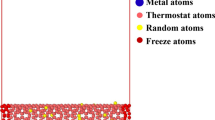Abstract
Electrical enhanced nanowelding of carbon nanotube (CNT) to metal is investigated using molecular dynamics simulation. It is found that attractions exerted by the charges can facilitate wetting of metal atoms with poor wetting ability onto the CNT surface at a much lower temperature, during which the CNT nailing into the semi molten metal bulk forms a new stable CNT–metal hybrid structure and therefore the electrical enhanced nanowelding is an irreversible process in case of removing the charges. Also, surface charges which induce great modification of CNT–metal interfacial configuration and lattice distortion can effectively facilitate the surface melting. As a result, more free metal atoms are involved in the welding.






Similar content being viewed by others
References
Alexander YL, Ali A (2003) Reconstruction of charged surfaces: general trends and a case study of Pt(110) and Au(110). Phys Rev B 68:245416
Andriotis A, Menon M, Gibson H (2008) Realistic nanotube-metal contact configuration for molecular electronics applications. IEEE Sens J 8:910
Arcidiacono S, Walther JH, Poulikakos D, Passerone D, Koumoutsakos P (2005) Solidification of gold nanoparticles in carbon nanotubes. Phys Rev Lett 94:105502
Chen JY, Kutana A, Collier CP, Giapis KP (2005) Electrowetting in carbon nanotubes. Science 310:1480
Chen CX et al (2007) A method for creating reliable and low-resistance contacts between carbon nanotubes and microelectrodes. Carbon 45:436
Chen MX, Song XH, Lv Q, Gan ZY, Liu S (2011) Bonding of carbon nanotubes onto microelectrodes by localized induction. Sens Actuators A:Phys 170:202
Chen CX, Jin TN, Zhang YF (2012) Progress in improvement methods of carbon nanotube/metal contact. J Inorg Mater 27:449
Daw B (1983) Semiempirical, quantum mechanical calculation of hydrogen embrittlement in metals. Phys Rev Lett 50:1285
De Volder MFL, Tawfick SH, Baughman RH, Hart AJ (2013) Carbon nanotubes: present and future commercial applications. Science 339:535
Dong LF, Youkey S, Bush J, Jiao J (2007) Effects of local Joule heating on the reduction of contact resistance between carbon nanotubes and metal electrodes. J Appl Phys 101:024320
Franklin AD et al (2012) Sub-10 nm carbon nanotube transistor. Nano Lett 12:758
Hoover WG (1985) Canonical dynamics: equilibrium phase-space distributions. Phys Rev A 31:1695
Hoover WG (1986) Constant-pressure equations of motion Phys Rev A 34:2499
Kutana A, Giapis KP (2006) Atomistic simulations of electrowetting in carbon nanotubes. Nano Lett 6:656
Peng Y, Cullis T, Inkson B (2009) Bottom–up nanoconstruction by the welding of individual metallic nanoobjects using nanoscale solder. Nano Lett 9:91
Plimpton SJ (1995) Fast parallel algorithms for short-range molecular dynamics. J Comp Phys 117:1
Shulaker MM et al (2013) Carbon nanotube computer. Nature 501:7468
Song XH, Zhao HD (2014) Computational study on bonding of carbon nanotubes onto metallic substrates. Microsyst Technol 20:397
Stuart SJ, Tutein AB, Harrison JA (2000) A reactive potential for hydrocarbons with intermolecular interactions. J Chem Phys 112:6472
Wang T, Jeppson K, Ye L, Liu J (2011) Carbon-nanotube through-silicon via interconnects for three-dimensional integration. Small 7:2313
Woo Y, Duesberg GS, Roth S (2007) Reduced contact resistance between an individual single-walled carbon nanotube and a metal electrode by a local point annealing. Nanotechnology 18:095203
Yang J, Hu W, Xiao S (2007) Surface melting of close-packed Mg(0001). Solid State Commun 143:545
Acknowledgments
This work is supported by National Natural Science Foundation of China (Grant No. 61106111).
Author information
Authors and Affiliations
Corresponding author
Rights and permissions
About this article
Cite this article
Song, X., Liu, J., Li, H. et al. Atomistic simulation of electrical enhanced nanowelding of carbon nanotube to metal. Microsyst Technol 21, 2215–2219 (2015). https://doi.org/10.1007/s00542-014-2341-2
Received:
Accepted:
Published:
Issue Date:
DOI: https://doi.org/10.1007/s00542-014-2341-2



